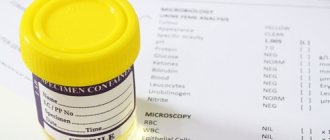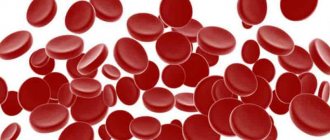Microalbuminuria (MAU) may be the first sign of kidney dysfunction and is characterized by abnormally high amounts of protein in the urine. Proteins such as albumin and immunoglobulins help blood clot, balance fluid in the body and fight infection.
The kidneys remove waste substances from the blood through millions of filtering glomeruli. Most proteins are too large to pass through this barrier. But when the glomeruli are damaged, proteins pass through them and enter the urine, which is what the microalbumin test reveals. People with diabetes or hypertension are more at risk.
What is albumin?
Albumin is a protein found in blood serum. It is formed mainly in liver cells (hepatocytes). Blood proteins maintain the so-called colloid osmotic pressure. It is about 25 mmHg. Art. in plasma (equivalent to approximately 3.3 kPa) and is important for establishing a balance between dissolved particles (colloids) inside and outside cells.
If osmotic pressure drops, the likelihood of edema increases. Since albumin makes up the largest proportion of blood proteins, it is also the most important factor in maintaining this pressure.
Albumin is an important carrier of substances in the bloodstream. Albumin binds and transports:
- Hormones: cortisol and thyroxine;
- Vitamin D;
- Fatty acid;
- Bilirubin (a degradation product of red blood pigment);
- Enzymes;
- Amino acids (building blocks of enzymes);
- Electrolytes (magnesium, calcium);
- Metals (copper ions);
- Anticoagulants, immunosuppressants or antibiotics.
Your doctor can test albumin in both serum and urine.
Bilirubin
Microalbuminuria - what is it?
Microalbuminuria is the excretion of small amounts of albumin (20 to 200 mg/L or 30 to 300 mg per day) in the urine. In diabetes or arterial hypertension, microalbuminuria occurs in approximately 10-40% of patients. The incidence of microalbuminuria is about 5-7%. The level of albumin excretion is an independent risk factor for the development of kidney and cardiovascular diseases - myocardial infarction, stroke or circulatory disorders. Individual differences in albuminuria levels can be detected soon after birth, and likely reflect individual differences in the function of endothelial cells—the innermost layer of blood vessels.
Albumen
Albumin is a relatively large, negatively charged protein. 99% of albumin passing through the blood barrier is taken up by cells in the uppermost part of the kidney tubules. High blood pressure and diabetes increase the pressure in the body of the kidneys and thus increase the amount of albumin filtered out. Hyperglycemia may reduce the negative charge of glomerular capillary endothelial cells and thus increase the permeability of the blood barrier to albumin.
Causes of high albumin levels
In patients with diabetes mellitus, the appearance of microalbuminuria marks the transition from the early stage of kidney damage with an increase in glomerular filtration rate (hyperfiltration stage) to the stage of progressive renal dysfunction. In people who do not have diabetes, microalbuminuria indicates an increased risk of developing overt kidney disease in the next few years. Protein in the urine in diabetes is a potentially dangerous sign.
Diabetics with microalbuminuria have an approximately 2.4-fold increased risk of death from cardiac complications compared with patients without it. Even in people with high blood pressure (hypertension) and in the normal population, the risk of developing cardiovascular disorders (morbidity) increases over the next 5 years. Microalbuminuria increases the risk of dementia and venous thromboembolism.
In industrialized countries, diabetic nephropathy is the leading cause of dialysis therapy. Initially, there is usually no renal dysfunction and the glomerular filtration rate is normal, with only microalbuminuria indicating the onset of renal damage. 10-50% of diabetics develop microalbuminuria depending on the duration of the disease.
Nephropathy
After several years, macroalbuminuria (>300 mg/day) can lead to end-stage renal failure. Only early detection and consistent treatment of microalbuminuria can prevent such consequences. In type I diabetics, microalbuminuria is a strong prognostic factor for diabetic nephropathy, in type II diabetes it is only a potential predictor,
About 5-32% of all patients with hypertension have microalbuminuria. A higher prevalence occurs in diabetes and hypertension.
In addition to increased mortality, patients also experience hyperlipidemia, left ventricular hypertrophy, renovascular disease, and arterial occlusive disease. In addition, hypertensive kidney disease can also lead to chronic renal failure in both children and adults.
Because the patient is usually clinically asymptomatic, microalbuminuria is often diagnosed only in late stages of development. For diagnosis, it is recommended to conduct a special analysis within 24 hours.
To diagnose incipient nephropathy, the only option available is the detection of microalbuminuria. Type I diabetics are expected to have kidney damage from years 5 to 10 of the disease. Because the onset of type II diabetes often precedes diagnosis, the patient should be regularly tested for microalbuminuria from the time of diagnosis. Patients should see a doctor every 3 months. Non-diabetic kidney disease can also cause proteinuria in diabetics.
Standard indicators
In an adult, the norm of UIA in urine should not exceed 30 mg/day. They should be practically absent in the urine of children. If albumin is released in quantities greater than 30 mg/day, this means that the patient develops mild nephropathy.
If more than 300 mg is excreted per day, this indicates that the kidneys are significantly affected. After 6 weeks, you need to retake the test to confirm the diagnosis. After this, the specialist prescribes treatment.
How to prepare for a daily UIA
Microalbuminuria is not detected by conventional urine dipsticks. Conventional rapid urine tests initially detect excretion of more than 300-500 mg of albumin per day. There are various methods for detecting pathology: radioimmunoassay, nephelometry, immunotumidimetry. The gold standard is the determination of albumin in urine collected over a 24-hour period. A urine test for the presence of microalbuminuria in diabetes mellitus is an important examination that helps to identify various complications.
Clinical manifestations
In a patient who has albumin in the body, the disease goes through the following stages:
- The asymptomatic stage, in which the patient does not feel a deterioration in health, but there are already certain changes in his urine.
- Initial stage . The patient has no symptoms of the disease and the level of microalbuminuria is no more than 30 ml per day.
- The prenephrotic stage makes it possible to detect it. The peculiarity of this stage is that the rate of renal filtration increases and hypertension occurs. An increase in the level of microalbuminuria to 300 ml is observed in the urine.
- Nephrotic stage. The patient experiences swelling and increased blood pressure. Protein increases in the urine, red blood cells appear, and sometimes even urea and creatinine increase.
- Stage of renal failure. During this period, blood pressure often rises and edema is constantly present. The analysis shows an increase in red blood cells, protein, creatinine and urea, as well as a lack of glucose. The kidneys do not secrete insulin.
Spontaneous remission and treatment with sartans
386 patients with insulin-dependent diabetes and microalbuminuria were observed for 6 years. In more than half (58%) of cases, microalbuminuria regressed spontaneously without treatment. Regression was more likely in patients whose HbA1c was less than 8%, systolic blood pressure less than 115 mmHg, total cholesterol less than 5.1 mmol/L, and triglycerides less than 1.6 mmol/L. Treatment with ACE inhibitors did not increase the number of remissions. Decisive for prognosis, however, is good control of cardiovascular risk factors.
Remission occurs more often in patients who lead a healthy lifestyle, the researchers noted. However, it is also important to take medications to reduce the risk of serious complications.
Although the beneficial effects of ACEIs on microalbuminuria in people with diabetes and normal blood pressure are well documented, this is not the case with angiotensin II receptor antagonists. A Dutch double-blind study that lasted just 10 weeks tested whether losartan could achieve the same effect. The study involved 147 people with diabetes and microalbuminuria, but with normal blood pressure. Losartan slightly reduced blood pressure, and creatinine clearance remained unchanged. As the study showed, losartan did not have a statistically significant effect, like other sartans, on the concentration of albumin in the blood plasma.
Losartan
Epidemiology
In 20-40% of diabetics who develop kidney disease, microalbumin can be detected in a urine sample. In 2-2.5% of diabetic patients with normal albumin excretion, microalbuminuria first appears in the first year of the disease. Type 1 diabetics are especially susceptible to the disease.
Advice! It is not recommended to “remove” excess protein using folk remedies or untested methods (diets). If you have high blood sugar and hypertension, you should consult a doctor.
Interesting:
- What are the blood sugar standards in young children, types of tests, causes of hyperglycemia, hypoglycemia, methods of prevention and treatment of deviations from the norm
- Indications for tests for diabetes mellitus, their information content and potential complications of the disease
- Is the presence of sugar in urine dangerous during pregnancy and what to do in this case?
- Reasons for the increase in the concentration of antibodies to the substance GAD, indications for the examination, preparation, contraindications and interpretation of the results
- Indications for analysis of blood sugar levels, information content of studies, interpretation of results and normal indicators
- Insulin rate 2 hours after a glucose load, indications, contraindications for the study, preparation and interpretation of results
- Preparation for the analysis of glycated hemoglobin in young children, the norm, information content of the study and interpretation of the results
Microalbumin tests
A general analysis of urine to detect the protein albumin is the only test that allows you to recognize the disease of nephropathy, and in the early stages. The disease nephropathy has several types, but it carries the concept of pathological processes that lead to damage to the renal structures and the kidneys in general.
Nephropathy has two distinct stages. At the first stage, changes in functional characteristics are practically not noticeable, but at the second stage, the manifestations are quite bright, but the development of kidney failure is already observed. In most cases, the first stage of nephropathy development can only be determined if a urine test is performed in a timely manner and albumin fractions are detected there.
It is worth remembering that microalbuminuria is one of the first stages that can be treated adequately in kidney disease.
An analysis may be prescribed for the following suspicions and pathological conditions:
- If you have diabetes - since this disease is directly related to the functioning of the urinary system. In order to monitor the functioning of the kidneys, tests for the presence of protein fractions are taken once every 6 months.
- For hypertension of a chronic nature. Kidney failure is often characterized by the presence of high blood pressure. This may be the first warning sign of kidney disease. To clarify the diagnosis, urine samples are taken for analysis.
- In case of heart failure - since poor blood supply leads to failure of the kidneys, kidney function decreases, and against this background, the development of kidney failure is possible.
- Symptomatic manifestations of nephropathy, which are characterized by pain in the lumbar column, weakness, the appearance of swelling on the body, and in particular on the face and hands, a feeling of thirst. But most often in the initial stages of nephropathy development, there are no symptoms.
- In autoimmune disorders - systemic lupus. This disease is characterized by damage to all organs and systems of the human body, and the kidneys are no exception.











